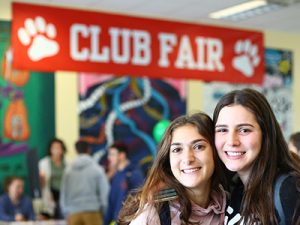Two classes at Yeshivat Frisch recently enjoyed interdisciplinary collaborations in the realm of kashrut. One of Rabbi Asher Bush’s junior Halacha classes recently learned about cheesemaking and Halacha, including kashrut-related aspects of the cheesemaking process, what level of supervision is halachically required and the halachic definition of cheese. They took a field trip to the Frisch cafeteria, where they got to make their own ricotta cheese—rumor has it, the cheese was delicious—with the help of Frisch’s mashgiach and kitchen staff.
Rabbi Bush is the chair of Frisch’s Halacha department, and utilizes a Halacha course textbook that he custom wrote for the course. The first half of the year focuses on halachic issues to do with health and medicine, while the second half of the year focuses on kashrut and bishul Shabbat. “In addition to showing the students that the Torah speaks about all parts of life, the topics selected in both parts of our course, the health and medicine as well as the kashrut, all enable the students to see Halacha as a dynamic process meeting the challenges of an ever changing world,” explained Rabbi Bush.
 The same week, Rabbi Bush, who has authored numerous scholarly articles along with two volumes of halachic responsa, visited Esther Ruskin’s junior zoology elective. Zoology students study the ecology, evolution and anatomy of all the major animal phyla, and had recently had the opportunity to dissect a shark. Rabbi Bush was invited to lead a discussion about the characteristics of kosher fish, and Ruskin was able to demonstrate them on the class’s dissection specimens. “When he explained that fish scales must be easily removable, I showed the students how easy it is to pull off scales from a perch fish,” said Ruskin.
The same week, Rabbi Bush, who has authored numerous scholarly articles along with two volumes of halachic responsa, visited Esther Ruskin’s junior zoology elective. Zoology students study the ecology, evolution and anatomy of all the major animal phyla, and had recently had the opportunity to dissect a shark. Rabbi Bush was invited to lead a discussion about the characteristics of kosher fish, and Ruskin was able to demonstrate them on the class’s dissection specimens. “When he explained that fish scales must be easily removable, I showed the students how easy it is to pull off scales from a perch fish,” said Ruskin.
By contrast, a shark’s scales cannot be removed without breaking the animal’s skin—which confirms the animal’s non-kosher status, according to Ramban. “By using a magnifying glass to observe the deeply embedded scales of a shark, the students were able to see for themselves why it is not a kosher animal,” said Ruskin. Rabbi Bush further explained that if a fish’s scales are only visible under a magnifying glass or a microscope (as in the case of some eels), they don’t qualify the fish as kosher. This rule has other applications too—for example, the presence of microscopic crustaceans, which cannot be seen by the naked eye, do not make water treif. Likewise, a crack in a mezuzah letter that can only be discerned under a microscope does not invalidate the klaf.
Ruskin enjoyed showing her students this real-life application to her course content, and her approach to zoology as a whole merges the realms of general and Jewish studies. “I include a quote from the Rambam on the course syllabi that I hand out on the first day of school each year: ‘When a person meditates on these matters and recognizes all the creations…and appreciates the wisdom of the Holy One, blessed be He, in all these creations, he will add to his love for God,’” she explained. “I always try to impress upon my students that science and Judaism are interconnected and are not in conflict. Learning science and attempting to better understand our world and how it works are amazing ways to know Hashem and appreciate all His amazing works.”







 The same week, Rabbi Bush, who has authored numerous scholarly articles along with two volumes of halachic responsa, visited Esther Ruskin’s junior zoology elective. Zoology students study the ecology, evolution and anatomy of all the major animal phyla, and had recently had the opportunity to dissect a shark. Rabbi Bush was invited to lead a discussion about the characteristics of kosher fish, and Ruskin was able to demonstrate them on the class’s dissection specimens. “When he explained that fish scales must be easily removable, I showed the students how easy it is to pull off scales from a perch fish,” said Ruskin.
The same week, Rabbi Bush, who has authored numerous scholarly articles along with two volumes of halachic responsa, visited Esther Ruskin’s junior zoology elective. Zoology students study the ecology, evolution and anatomy of all the major animal phyla, and had recently had the opportunity to dissect a shark. Rabbi Bush was invited to lead a discussion about the characteristics of kosher fish, and Ruskin was able to demonstrate them on the class’s dissection specimens. “When he explained that fish scales must be easily removable, I showed the students how easy it is to pull off scales from a perch fish,” said Ruskin.